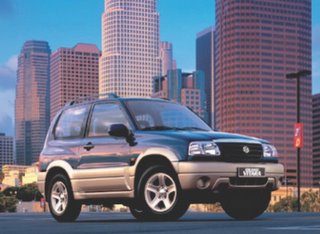50,000 Fleet Vehicles Ordered

Suzuki Gran Vitara
At least, that is what Nicholas Kristof of the NY Times has suggested in his belief that Plug-Ins are today's answer to tomorrow's needs.
He also makes the point, that plug ins will provide more energy security and less global warming.
That is because electric fuel can be provided by renewable energy such as the wind.
Here is part of the NY Times editorial.
The full editorial is available to Times Select subscribers.
100-M.P.G. Cars: It's a Start
New York Times
by Nicholas Kristof
Feb. 5, 2006
Imagine if we could develop a passenger car that averaged more than 100 miles per gallon — or, if used only for short trips, 1,000 miles per gallon. What if it could cost the equivalent of only 75 cents a gallon to operate and needed to go to a filling station only every other month?
Surprise — we have all that technology today! We even have a handful of demonstration vehicles to prove it. All we lack is bold political and corporate leadership to put this technology in play immediately.
The cars I'm talking about are known as "plug-in hybrids." They are similar to hybrids like the Toyota Prius, but they have bigger batteries and at night would be plugged into a standard 120-volt outlet to charge the batteries.
They can be built to have a 30- to 50-mile range before the gasoline engine needs to be used at all. So for someone who commutes 15 miles each way to work and rarely takes long drives, a plug-in hybrid usually functions as an electric vehicle and relies on gas only on rare occasions.
"If you used it only locally, you would go to a gas station only a couple of times a year," said Felix Kramer, founder of CalCars.org, a nonprofit in Palo Alto, Calif., that converted a regular Prius to a plug-in hybrid. "This can be done right now. That's why people are so excited."
(clip)
Another advantage is that plug-ins fit easily into the existing infrastructure, unlike cars fueled by hydrogen. At least at home, the infrastructure is as simple as an extension cord.
"None of this requires a Manhattan Project," notes James Woolsey, the former C.I.A. director, an ardent fan of plug-in hybrids to achieve greater energy autonomy and stop subsidizing extremism and dictatorships in the Middle East. Now, he says, government incentives are needed so that auto companies take the financial risk of producing plug-in hybrids.
(clip)
The Bush administration is backing the technologies that go into plug-in hybrids, but languorously. Instead, the U.S. should promise to order 50,000 fleet vehicles of the first viable plug-in hybrid — that would be just the stimulus the carmakers need.
Mr. Bush was forthright in acknowledging America's oil addiction, but he sometimes sounded like an addict who declares he's going to quit "tomorrow."
Let's start now. "
Become a Partner today.
Sign the On Line Petition
more news
Mayor Menino joins effort
Home

0 Comments:
Post a Comment
<< Home